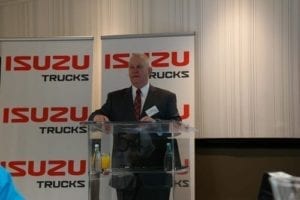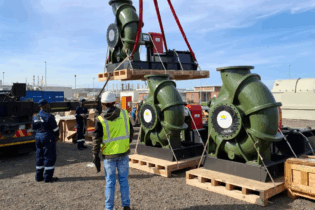CU: We are developing a used trucks business. It’s about supply and demand. Supply of used trucks is a big problem; our dealers are mostly trading competitor trucks. The average number of owners of an Isuzu truck is 1.7 per life of the truck. The average of competitor trucks is more towards 2.5 and three.
Our customers run our trucks longer. We gain with value-added support structures that get a better economic life out of our trucks. When an owner gets to sell his/her truck he/she’s got a row of buyers offering retail prices, before a dealer can even trade it in at wholesale pricing. Other territories in the world have the same problem. It’s a brand problem. It’s a nice brand problem to have because we benefit on Full Maintenance Leasing (FML). We are trying some initiatives, but, at the same time, we are not going to just lawn the stock into used trucks for the sake of doing so. We’ve got to preserve that value. TWA: Are you developing an in-house tracking system? CU: That’s in the mix. We’ve got to decide if we go that route ourselves or if we use a supplier. There is no totally dominant system and, if we put in system A, customer B or C might say they don’t use that. So, at this stage, we allow the normal free market force to dictate what customers want in their vehicles. In this environment, we don’t want to create unnecessary cost. We are playing it a little bit safe at the moment and will let local demand trends take their course. TWA: Are your customers buying down? CU: There is not any one particular buying down trend – it’s a need. If a customer was looking at using two four-tonners, he would now buy one eight-tonner. That’s because he’d choose lower operating costs – one driver and one insurance policy – that’s a trend. The other [trend] is the guy who was buying a 12 or 14-tonner, but his loads have diminished and so now he’d rather be putting an 8-tonner into his fleet to get the correct utilisation. He’s still filling the truck, but he’s not carrying around a lot of fresh air. TWA: Given the rand, truck prices will surely rise… CU: Everyone has to be competitive. The fact of the matter is if we stay as we are, depending on which currency you look at, anything between 25% and 30% is what the cost of a truck (that comes in a box and which is built in South Africa under the current legislation) has risen by. We can kill demand if everyone adjusts prices 30%. That’s not realistic. I’m guessing; if I look at the price average between what was published in January and February and what has been told to the franchise dealer networks will be effective 1 April, you are already looking at an average 10% price increase. That’s just in the first two quarters. Will it recover the 30%? Probably not. Historically, we could rely on it coming back at least 20%, with the 10% covering the needs of the new business.”
Transport World Africa attended Isuzu Trucks’ ‘State of the Nation’ address earlier this week, which was delivered, without heckling, by Isuzu Trucks South Africa’s chief operations officer, Craig Uren.
Uren spoke openly about the company’s sales results, its export performance, used trucks and all things trucking in South Africa right now…
TWA: New Isuzu truck sales were pretty good last year – what about your export performance?
CU: Our export numbers have grown quite significantly. We made products available for export in the period July to October (2015). We also took stock out of our local system and put them into exports, which created a 200-unit backlog. We caught this up in October/November/December production. Then, close on 200 units were put into Kanu, for deliveries to some parastatals.
It was all planned from July onwards, through to the end of the year. The difference between the 400 units and 600 units sold (December 2015 vs January 2016), was due to customers wanting to take delivery last year, not this year because pricing increases came into effect in January. So it was about delivering on the old price, not the new price.
4 500 units were the total number sold last year. If you look at our growth rates for the year, they have been pretty consistent. What we build, we sell (around 370/380 to 400 units a month). Dealers have to hit their targets, but there was no incentives offered to them to get the numbers up.
TWA: What about the used trucks business?









